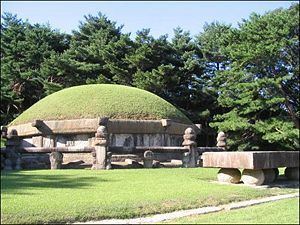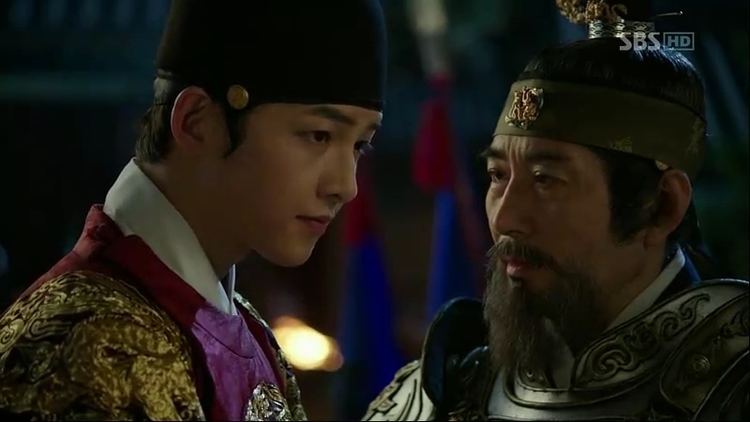Successor Sejong of Joseon Name Taejong Joseon | Role King Issue Sejong of Joseon Parents Taejo of Joseon | |
Reign November 13, 1400 – September 18, 1418 Born June 13, 1367Hamheung ( 1367-06-13 ) Spouse Queen Wongyeong (m. ?–1420) Children Sejong the Great, Prince Yangnyeong, Prince Hyoryeong Similar People Taejo of Joseon, Jeong Do‑jeon, Sejong the Great, Sejo of Joseon, Jeong Mong‑ju | ||
Taejong of Joseon (13 June 1367 – 30 May 1422) was the third king of the Joseon dynasty in Korea and the father of King Sejong the Great.
Contents
- Founding of Joseon
- Strife of princes
- Consolidation of royal power
- Absolute monarchy
- Family
- His full posthumous name
- Modern depictions
- Actors who have played King Taejong
- References

Founding of Joseon

He was born as Yi Bang-won in 1367 as the fifth son of King Taejo, and was qualified as an official of Goryeo Dynasty in 1382. During his early days, he helped his father to extend his support with the citizens and many influential figures of the government. Taejong helped his father found a new dynasty by assassinating powerful officials such as Jeong Mong-ju, who remained loyal to the Goryeo dynasty. He was called as Prince Jeong-an during the reign of King Taejo.
Strife of princes

In 1392 he helped his father overthrow Goryeo in order to establish a new dynasty, Joseon. He expected to be appointed as the successor to the throne for he contributed most to the founding of Joseon, but his father, Taejo, and prime minister Jeong Do-jeon favored Taejo's eighth son and Yi Bangwon's half-brother (second son of Queen Sindeok), Yi Bangseok, as the crown prince. This conflict arose chiefly because Jeong Dojeon, who shaped and laid down ideological, institutional and legal foundations of the new dynasty more than anyone else, saw Joseon as a kingdom led by ministers appointed by the king while Yi Bangwon wanted to establish the absolute monarchy ruled directly by the king. Both sides were well aware of each other's great animosity and were getting ready to strike first. After the sudden death of Queen Sindeok, and while King Taejo was still in mourning for his second wife, Yi Bang-won struck first by raiding the palace and killed Jeong Do-jeon and his supporters, as well as Queen Sindeok's two sons including the crown prince in 1398. This incident became known as the First Strife of Princes.

Aghast at the fact that his sons were willing to kill each other for the crown, and psychologically exhausted from the death of his second wife, King Taejo abdicated and immediately crowned his second son Yi Bang-gwa, or King Jeongjong, as the new ruler. One of King Jeongjong's first acts as monarch was to revert the capital to Gaeseong, where he is believed to have been considerably more comfortable. Yet Yi Bangwon retained real power and was soon in conflict with his disgruntled older brother Yi Bang-gan, who also yearned for power. In 1400, General Bak Po, who was disappointed by Yi Bangwon for not rewarding him enough for his action in the First Strife of Princes, allied with Bangwon's older brother Yi Bang-gan (Prince Hoean) and rebelled against him in what came to be known as the Second Strife of Princes. Yi Bangwon successfully defeated his brother's forces, then executed Bak Po and sent Yi Bang-gan into exile. King Jeongjong, who was afraid of his powerful brother, named Yi Bangwon as crown prince and abdicated in the same year. Yi Bangwon assumed the throne of Joseon at long last as King Taejong, the third King of Joseon.
Consolidation of royal power

In the beginning of Taejong's reign, the Grand King Former, Taejo, refused to relinquish the royal seal that signified the legitimacy of any king's rule. Taejong began to initiate policies he believed would prove his qualification to rule. One of his first acts as king was to abolish the privilege enjoyed by the upper echelons of government and the aristocracy to maintain private armies. His revoking of such rights to field independent forces effectively severed their ability to muster large-scale revolts, and drastically increased the number of men employed in the national military. Taejong's next act as king was to revise the existing legislation concerning the taxation of land ownership and the recording of state of subjects. With the discovery of previously hidden land, national income increased twofold.

He also initiated the system of hopae, an early form of identification recording the bearer's name and residence, used to control the movement of people. He also set a big drum in front of his court, so that the common people, when they had some problems, could come to the palace and consult the king.
Absolute monarchy

In addition, he created a strong central government and an absolute monarchy. In 1399, Taejong had played an influential role in scrapping the Dopyeong Assembly, a council of the old government administration that held a monopoly in court power during the waning years of the Goryeo dynasty, in favor of the State Council of Joseon (의정부), a new branch of central administration that revolved around the king and his edicts. After passing the subject documentation and taxation legislation, King Taejong issued a new decree in which all decisions passed by the State Council could only come into effect with the approval of the king. This ended the custom of court ministers and advisors making decisions through debate and negotiations amongst themselves, and thus brought the royal power to new heights. Shortly thereafter, Taejong installed an office, known as the Sinmun Office, to hear cases in which aggrieved subjects felt that they had been exploited or treated unjustly by government officials or aristocrats.
However, Taejong kept Jeong Do-jeon's reforms intact for the most part. He promoted Confucianism, which was more like political philosophy rather than a religion, thus demoting Buddhism, which was far from daily living and decayed from the power given by Goryeo kings back then. He closed many temples that were established by Goryeo kings, and seized their large possessions and added them to the national treasury. Meanwhile, he honored Jeong Mong-ju with the posthumous title of Chief State Councillor (equivalent to Prime Minister), even though it was he who assassinated Jeong — leading to an irony of history, in which Jeong Do-jeon was vilified throughout the Joseon dynasty while Jeong Mong-ju was honored despite his opposition to its birth.
In foreign policy, he was a straight hardliner — he attacked the Jurchens on the northern border and Japanese pirates on the southern coast. Taejong is also known for being responsible for the Ōei Invasion of Tsushima Island in 1419. He also promoted publications, commerce and education. He also founded and encouraged Uigeumbu, the royal guard and secret police at the same time. In 1418, he abdicated and gave the throne to Sejong the Great of Joseon, but continued to rule with an iron fist, deciding important matters and executing Sejong's father-in-law Shim On and Shim's brother.
Taejong executed or exiled many of his supporters who helped him ascend to the throne in order to strengthen the royal authority. To limit influence of in-laws, he also killed all four brothers of his Queen Won-gyeong and his son Sejong's in-laws. Taejong remains a controversial figure who killed many of his rivals (including Jeong Mong-ju and Jeong Do-jeon) and relatives to gain power and yet ruled effectively to improve the populace's lives, strengthen national defense, and lay down a solid foundation for his successor Sejong's rule. Taejong was known for his passion for hunting, considered unseemly in a ruler.
Family
- Queen Wongyeong of the Yeoheung Min clan (11 July 1365 – 10 July 1420) (원경왕후 민씨)
- Yi Je, Grand Prince Yangnyeong (1394 – 7 September 1462) (이제 양녕대군)
- Yi Bo, Grand Prince Hyoryeong (6 January 1396 – 12 June 1486) (이보 효령대군)
- Yi Do, Grand Prince Chungnyeong (15 May 1397 – 8 April 1450) (이도 충녕대군)
- Yi Jong, Grand Prince Seongnyeong (3 August 1405 – 11 April 1418) (이종 성녕대군)
- Princess Jeongsun (1385 – 25 August 1460) (정순공주)
- Princess Gyeongjeong (1387 – 6 June 1455) (경정공주)
- Princess Gyeongan (1393 – 30 May 1415) (경안공주)
- Princess Jeongseon (1404 – 25 February 1424) (정선공주)
- Royal Noble Consort Hyo of the Cheongpung Kim clan (? – 1454) (효빈 김씨)
- Yi Bi, Prince Gyeongnyeong (13 December 1395 – 1458) (이비 경녕군)
- Royal Noble Consort Shin of the Yeongwol Shin clan (? – 1435) (신빈 신씨)
- Yi In, Prince Hamnyeong (1402 – 1467) (이인 함녕군)
- Yi Jeong, Prince Onnyeong (1407 – 1453) (이정 온녕군)
- Princess Jeongshin (? – 26 September 1457) (정신옹주)
- Princess Jeongjeong (1410 – 1455) (정정옹주)
- Princess Sukjeong (? – 1456) (숙정옹주)
- Princess Soshin (? – 1437)(소신옹주)
- Princess Suknyeong (숙녕옹주)
- Princess Sukgyeong (1420 – 1494) (숙경옹주)
- Princess Sukgeun (? – 1450) (숙근옹주)
- Royal Noble Consort Seon of the Sunheung Ahn clan (? – 1468) (선빈 안씨)
- Yi Jeong, Prince Hyeryeong (1407 – 1440) (이정 혜령군)
- Yi Chi, Prince Iknyeong (1422 – 1464) (이치 익녕군)
- Princess Sosuk (? – 1456) (소숙옹주)
- Princess Gyeongshin (경신옹주)
- Royal Noble Consort of the Andong Kim clan (? - 1479) (명빈 김씨)
- Princess Sukan (? – 1464) (숙안옹주)
- Royal Noble Consort Ui of the Andong Kwon clan (의빈 권씨)
- Princess Jeonghye (정혜옹주)
- Royal Noble Consort So of the Jangyeon No clan (? – 1479) (소빈 노씨)
- Princess Sukhye (? – 1464) (숙혜옹주)
- Royal Noble Consort Jeong of the Go clan (? – 1426) (정빈 고씨)
- Yi Nong, Prince Geunnyeong (1411 – 1462) (이농 근녕군)
- Royal Consort Suk-ui of the Choi clan (숙의 최씨)
- Yi Ta, Prince Huiryeong (? – 1465) (이타 희령군)
- An unnamed daughter
- Royal Consort Suk-ui of the Lee clan (숙의 이씨)
- Yi Gan, Prince Huryeong (1419 – 6 October 1450) (이간 후령군)
- Lady Deoksuk of the Lee clan (덕숙옹주 이씨)
- Princess Suksun (숙순옹주)
- Lady Sukgong of the Cheongdo Kim clan (숙공궁주 김씨)
- Lady Uijeong of the Hanyang Jo clan (? – 1454) (의정궁주 조씨)
- Lady Hyesun of the Hampyeong Lee clan (? – 1438) (혜순궁주 이씨)
- Lady Shinsun of the Seongsan Lee clan (1390 – ?) (신순궁주 이씨)
- Princess Hyeseon of the Hong clan (혜선옹주 홍씨)
- Princess Sunhye of the Andong Jang clan (? – 26 July 1423) (순혜옹주 장씨)
- Princess Seogyeong (서경옹주)
His full posthumous name
Modern depictions
Tears of the Dragon, a popular KBS television historical drama that aired from 1996–8, portrayed Taejong's life. It depicts him as being committed to the stability of the kingdom, a commitment that translated into affection and devotion towards his father and heir (originally Taejong's firstborn son), although these feelings were not reciprocated due to anger about the 1398 assassinations. The anger culminated in the retired Taejo's efforts to remove Taejong by backing the Jo Sawi's rebellion and personally shooting an arrow at him during a reconciliation meeting. According to the series, Taejong grew to become perpetually suspicious of others around him (especially his in-laws), resulting in purges, a typical example being his execution of the queen's influence-peddling-but-loyal oldest brothers and naїvely-innocent youngest brothers. In disgusted response, his Crown Prince rejected the throne to become a playboy and his second-born son joined the Buddhist priesthood, deferring the position to the third-born son.
King Taejong is also depicted in the 2008 KBS historical drama King Sejong the Great about his third son and successor King Sejong, the 2011 SBS drama Deep Rooted Tree, the 2012-13 SBS drama The Great Seer, the 2014 KBS drama Jeong Do-jeon, the 2015 SBS drama Six Flying Dragons, and the 2016 KBS historical science drama Jang Yeong-sil.
